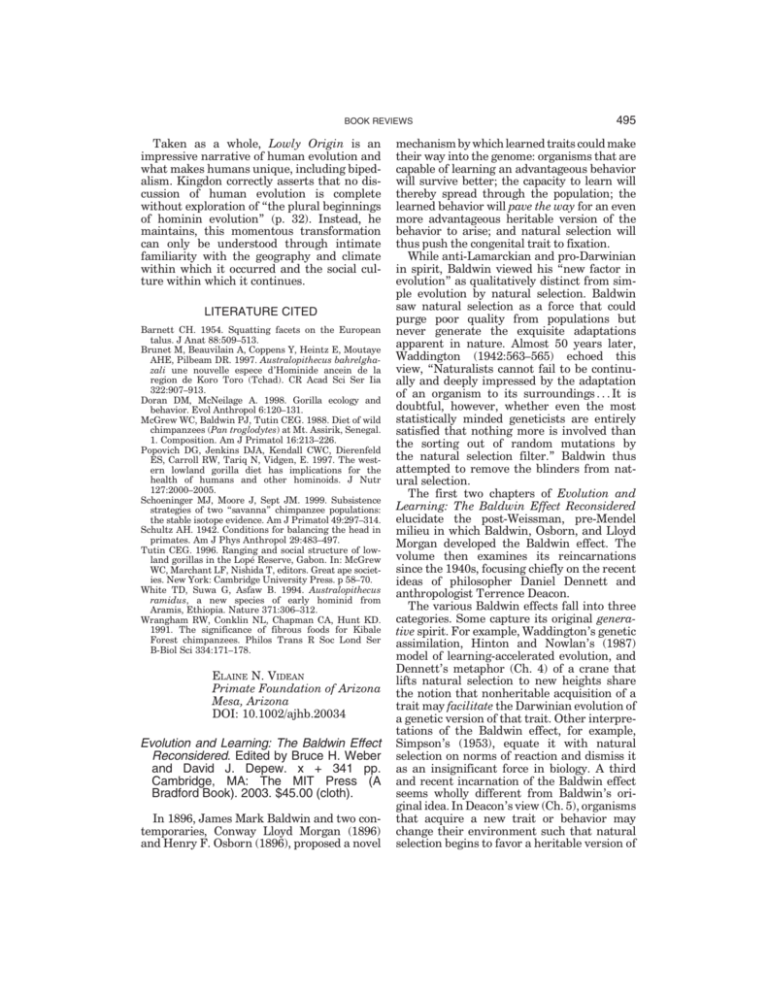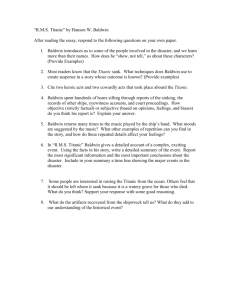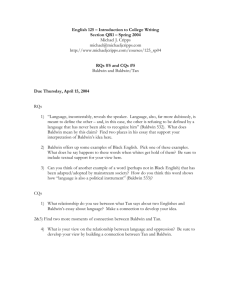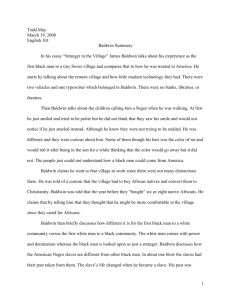Taken as a whole, Lowly Origin is an impressive narrative of human
advertisement

BOOK REVIEWS Taken as a whole, Lowly Origin is an impressive narrative of human evolution and what makes humans unique, including bipedalism. Kingdon correctly asserts that no discussion of human evolution is complete without exploration of ‘‘the plural beginnings of hominin evolution’’ (p. 32). Instead, he maintains, this momentous transformation can only be understood through intimate familiarity with the geography and climate within which it occurred and the social culture within which it continues. LITERATURE CITED Barnett CH. 1954. Squatting facets on the European talus. J Anat 88:509–513. Brunet M, Beauvilain A, Coppens Y, Heintz E, Moutaye AHE, Pilbeam DR. 1997. Australopithecus bahrelghazali une nouvelle espece d’Hominide ancein de la region de Koro Toro (Tchad). CR Acad Sci Ser Iia 322:907–913. Doran DM, McNeilage A. 1998. Gorilla ecology and behavior. Evol Anthropol 6:120–131. McGrew WC, Baldwin PJ, Tutin CEG. 1988. Diet of wild chimpanzees (Pan troglodytes) at Mt. Assirik, Senegal. 1. Composition. Am J Primatol 16:213–226. Popovich DG, Jenkins DJA, Kendall CWC, Dierenfeld ES, Carroll RW, Tariq N, Vidgen, E. 1997. The western lowland gorilla diet has implications for the health of humans and other hominoids. J Nutr 127:2000–2005. Schoeninger MJ, Moore J, Sept JM. 1999. Subsistence strategies of two ‘‘savanna’’ chimpanzee populations: the stable isotope evidence. Am J Primatol 49:297–314. Schultz AH. 1942. Conditions for balancing the head in primates. Am J Phys Anthropol 29:483–497. Tutin CEG. 1996. Ranging and social structure of lowland gorillas in the Lopé Reserve, Gabon. In: McGrew WC, Marchant LF, Nishida T, editors. Great ape societies. New York: Cambridge University Press. p 58–70. White TD, Suwa G, Asfaw B. 1994. Australopithecus ramidus, a new species of early hominid from Aramis, Ethiopia. Nature 371:306–312. Wrangham RW, Conklin NL, Chapman CA, Hunt KD. 1991. The significance of fibrous foods for Kibale Forest chimpanzees. Philos Trans R Soc Lond Ser B-Biol Sci 334:171–178. ELAINE N. VIDEAN Primate Foundation of Arizona Mesa, Arizona DOI: 10.1002/ajhb.20034 Evolution and Learning: The Baldwin Effect Reconsidered. Edited by Bruce H. Weber and David J. Depew. x + 341 pp. Cambridge, MA: The MIT Press (A Bradford Book). 2003. $45.00 (cloth). In 1896, James Mark Baldwin and two contemporaries, Conway Lloyd Morgan (1896) and Henry F. Osborn (1896), proposed a novel 495 mechanism by which learned traits could make their way into the genome: organisms that are capable of learning an advantageous behavior will survive better; the capacity to learn will thereby spread through the population; the learned behavior will pave the way for an even more advantageous heritable version of the behavior to arise; and natural selection will thus push the congenital trait to fixation. While anti-Lamarckian and pro-Darwinian in spirit, Baldwin viewed his ‘‘new factor in evolution’’ as qualitatively distinct from simple evolution by natural selection. Baldwin saw natural selection as a force that could purge poor quality from populations but never generate the exquisite adaptations apparent in nature. Almost 50 years later, Waddington (1942:563–565) echoed this view, ‘‘Naturalists cannot fail to be continually and deeply impressed by the adaptation of an organism to its surroundings . . . It is doubtful, however, whether even the most statistically minded geneticists are entirely satisfied that nothing more is involved than the sorting out of random mutations by the natural selection filter.’’ Baldwin thus attempted to remove the blinders from natural selection. The first two chapters of Evolution and Learning: The Baldwin Effect Reconsidered elucidate the post-Weissman, pre-Mendel milieu in which Baldwin, Osborn, and Lloyd Morgan developed the Baldwin effect. The volume then examines its reincarnations since the 1940s, focusing chiefly on the recent ideas of philosopher Daniel Dennett and anthropologist Terrence Deacon. The various Baldwin effects fall into three categories. Some capture its original generative spirit. For example, Waddington’s genetic assimilation, Hinton and Nowlan’s (1987) model of learning-accelerated evolution, and Dennett’s metaphor (Ch. 4) of a crane that lifts natural selection to new heights share the notion that nonheritable acquisition of a trait may facilitate the Darwinian evolution of a genetic version of that trait. Other interpretations of the Baldwin effect, for example, Simpson’s (1953), equate it with natural selection on norms of reaction and dismiss it as an insignificant force in biology. A third and recent incarnation of the Baldwin effect seems wholly different from Baldwin’s original idea. In Deacon’s view (Ch. 5), organisms that acquire a new trait or behavior may change their environment such that natural selection begins to favor a heritable version of 496 BOOK REVIEWS the trait. This idea of Baldwinian niche construction shifts the locus of evolutionary facilitation from genes to environment. In Chapter 8, Brian Hall points to a shortcoming of this volume and of the literature on the Baldwin effect generally: lack of empirical support. Waddington (1952) artificially selected Drosophila traits that were induced by heat shock. After a modest number of generations, the populations began to exhibit the trait even in the absence of heat shock, demonstrating that a heritable trait could replace an environmentally triggered version of the same trait. Although this result is one of the best empirical tests so far of the Baldwin effect, it falls far short of establishing its natural significance. Interestingly, many of the contributors to this volume—philosophers, psychologists, developmental biologists, and computer scientists—seek Baldwinian explanations for the human mind and language, traits much more complex than those Waddington considered. Empirical support for such explanations is barely discussed, apparently because it does not exist. Noticeably absent are contributions from evolutionary biologists. Although the evolutionary literature rarely mentions the Baldwin effect per se, it has much to say about its recent incarnations, namely, niche construction and epigenetic inheritance. For example, Lewontin (1983) introduced the concept of niche construction in the early 1980s and Odling-Smee, Laland, and Feldman (2003) and others have since developed extensive theory and empirical support for it. Chapter 10 by Paul Griffith does, however, connect the Baldwin effect to such modern evolutionary theory. Complaints aside, the book is thought-provoking and enjoyable. Baldwin probably did not consider many of the hypotheses now attributed to him. Yet casting them side-byside may facilitate cross-pollination and certainly provides insight into the evolution of scientific thought. With this book in hand, researchers should now turn from the ‘‘what is’’ of the Baldwin effect to rigorous examination of its various forms. LITERATURE CITED Baldwin JM. 1896. A new factor in evolution. Am Nat 30:441–451, 536–663. Hinton, GE Nowlan SJ. 1987. How learning can guide evolution. Complex Systems 1:495–502. Lewontin RC. 1983. Gene, organism, and environment. In: Bendall DS, editor. Evolution from molecules to men. Cambridge, UK: Cambridge University Press. p 273–285. Lloyd Morgan C. 1896. On modification and variation. Science 4:733–740. Odling-Smee FJ, Laland KN, Feldman MW. 2003. Niche construction: the neglected process in evolution. Monographs in Population Biology, vol. 37. Princeton, NJ: Princeton University Press. Osborn HF. 1896. A mode of evolution requiring neither natural selection nor the inheritance of acquired characteristics. Trans NY Acad Sci 15:141–142, 148. Simpson GG. 1953. The Baldwin effect. Evolution 7:110–117. Waddington CH. 1942. Canalization of development and the inheritance of acquired characters. Nature 3811:536–565. Waddington CH. 1952. Genetic assimilation of an acquired character. Evolution 7:118–126. LAUREN ANCEL MEYERS Integrative Biology The University of Texas at Austin Austin, Texas DOI: 10.1002/ajhb.20035 Life’s Solution: Inevitable Humans in a Lonely Universe. By Simon Conway Morris. xxii + 464 pp. Cambridge, UK: Cambridge University Press. 2003. $30.00 (cloth). In a perfect world we would be able to spend as much time reading the primary literature of all the fields which interest us as we spend producing our own small contribution to it. In the real world, at least in my real world, the stack of interesting reads just grows and grows. Simon Conway Morris takes you to that perfect world in his wide-ranging and eminently readable Life’s Solution. Reading this book is like taking a short-cut through that big stack of articles on your desk. You may not have reached the same synthesis as Conway Morris if you had set about the same task, but it does make you appreciate why his work is so widely read. On the surface the book is a neat and readable synthesis of the overarching biophysical and geochemical evidence of early life, the design of life forms and the improbabilities that such a story arc could have happened in any other way. Underneath is the pointed and prevailing thesis, explicit on p. 223, that evolution is best viewed as a series of inevitable states of being: ‘‘If ‘we’ had not emerged, then . . . rest assured that a viviparous, warm-blooded, vocalizing and intelligent species would have done so.’’ Well, that says it all. I am a ‘‘patternist’’ and so I like the attention that Conway Morris






